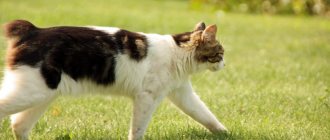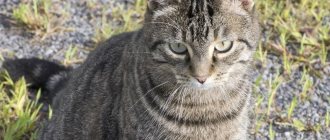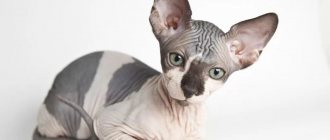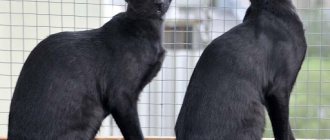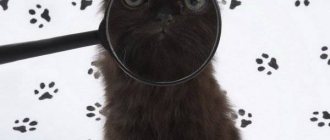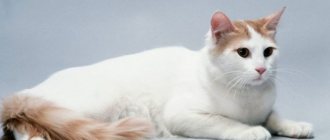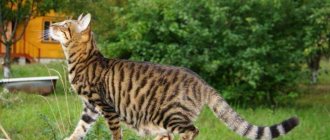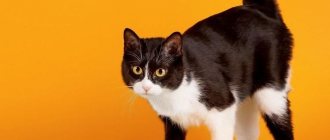Video
* We invite you to watch a video about the Abyssinian cat . In fact, in front of you is a playlist in which you can select and watch any of 20 videos about a given cat breed by simply clicking on the button in the upper right corner of the window. In addition, the material contains quite a lot of photos. By looking at them you can find out what an Abyssinian cat looks like.
In this article:
|
Rate the material!
[Total votes: 3 Average: 3.7]
The Abyssinian cat is an animal artificially bred in the UK, which is now so loved by many that it is rightfully considered a popular domestic breed. These cats were among the first to participate in exhibitions. They can be different in appearance, and also exhibit many positive character traits, which makes them so popular.
History of the origin of Abyssinian cats
Abyssinian cats have been especially popular in the USA and Europe for many years. But in Russia they appeared relatively recently and managed to quickly win the love of many. There are a variety of versions regarding the origin of the breed as such.
The most popular is the one that claims the origin of cats from Ethiopia. The name speaks to this, because in ancient times Ethiopia was indeed called Abyssinia. From there the seals were brought to Great Britain, where they were repeatedly crossed with representatives of other local breeds. As a result of this, after many years, the breed that we all see now appeared.
According to another version, these are direct descendants of Egyptian cats. There is also a version that these are domesticated descendants of African cats who arrived from the Middle East. There is also the simplest version, which can be criticized by many experts. This version is that the breed was created in Great Britain artificially, simply after crossing local breeds. That would explain a lot. In particular, such a large process of genetic defects and infertile females.
One way or another, the breed began to develop most actively in Great Britain, where in the future representatives of the species were crossed with others in order to obtain the most ideal combination.
These cats were officially registered at the end of the 19th century. Afterwards, the breed went through a lot of different metamorphoses, so that later it could reach other countries in the form in which everyone sees it now. Today, many breeders are actively working to preserve the breed in its original form without impurities.
Abyssinian cat - description of the breed
Abyssinian cats are medium in size. They cannot be called small or large. In many ways they are similar to the Bengal breed. Both of them are particularly versatile, easy to care for and suitable even for people with allergies. It's simple: the coat is very short and lies tightly to the body. That is why many people even form the opinion that the cat has a bald body.
Ticked color (a combination of dark and light shades in one hair) is what is typical for newborn representatives of the breed. The ears of these cats are quite massive - they have a wide base and rounded tips.
The most expressive eyes of these cats are their eyes. Green, walnut, yellow and all sorts of shades of these colors are not a complete list of their colors. A long tail and thin paws are other distinctive features of representatives of this breed.
In general, the body of the Abyssinian cat is extremely flexible and sinewy. The muscles (especially in the chest area) are developed. Although these animals are often called not beautiful enough, it is absolutely impossible to agree with this. Original colors, extreme grace - what more could you wish for?
Such a cat initially gets used to being the center of attention and then simply cannot live without it. Abyssinians will be ideal partners and companions. Thanks to their small dimensions, they can easily be taken on trips, which will be another undeniable advantage.
Since the breed is easy to train, it is perfect for apartments. After all, there you need to accustom the cat to the tray without harming the furniture or repairs. This certainly won’t be a problem with this breed.
Abyssinian breed standards
However, experienced breeders have abandoned this division and strive to work with a modern type that meets the standards of all felinological systems. Standing somewhat apart are overly extreme cats, in which the harmony of the ideal appearance is disrupted by exaggeration of breed traits. Where did the division into types come from? This was facilitated by breeders who wanted to improve and develop the breed, raising thinner and more vocal Abyssinian cats in their nurseries as opposed to the somewhat outdated stocky and squat animals.
BODY
In all four systems (FIFe, WCF, TICA and CFA) it should be of medium length, flexible, muscular and firm to the touch. At the same time, the animal looks graceful and elegant.
FIFe experts note a stocky physique as a disadvantage.
The TICA standard emphasizes that the chest should be round and not flattened. The back is slightly arched, as if the cat is about to jump.
And the CFA standard calls attention to the fact that the Abyssinian's physique should be average between two extremes - stocky and delicately lean.
Both American systems value in these cats not size, but proportionality and overall harmony. In this regard, in any association, old-type animals are perceived as overly powerful and rude. However, going too far with extremes is not recommended, as it leads to overly stretched animals that look like Orientals, which should not be the case.
HEAD
Wedge-shaped with smoothly rounded contours - all four felinological systems recognize this, resorting to the use of synonyms in the standard in order to differ from each other.
- The nose should be of medium length,
- chin - strong (not slanted or protruding).
- The rise from the bridge of the nose to the forehead is without sharp breaks.
- Profile - with an easy transition.
American systems specifically stipulate the absence of straight lines in the silhouette of the head, as well as flat areas on the skull. The CFA standard states that the forehead should be wide, and wide cheekbones are acceptable in adult cats. In FIFe, CFA, TICA, pinch is unacceptable, but in WCF this clause is not prescribed. In CFA, a round or long and narrow (Siamese type) head is a disadvantage, in FIFe it is a disqualifying feature. There is no such indication in the other two systems.
EARS
Large (or relatively large as required by FIFe), wide at the base, widely spaced. Thanks to the posture, it seems that the cat is on the alert. Slightly rounded tips are welcomed in European systems, moderately pointed in American systems. But in FIFe, small and pointed ears are considered a significant disadvantage. Also, the CFA and TICA standards specify that the coat, even on the ears, must have ticking.
Experts of the two European systems want to see tassels on the ears, but the Americans do not require this. Before American rings, breeders even specifically trim the animals’ ears, removing tassels and brushes so that they appear large and open.
EYES
Large, almond-shaped, widely spaced - all felinological systems agree on this, as well as on the fact that they should be shiny and expressive, and the color should be pure and intense.
The CFA specifies that eyes cannot be round or “oriental.”
Several colors are acceptable: amber, green and yellow (amber to green in WCF, gold, copper, green or hazel in TICA).
The WCF states that green is the preferred color for silver colors.
LIMBS
Long, slender, muscular, but at the same time graceful, proportional to the body. The paws are small and oval. All four associations are unanimous on this.
TAIL
The standards of all associations say that it should be fairly long, tapering at the end, and wide (or thick) at the base.
WOOL
Marked as short in European standards and medium length in American standards. Thin, shiny, glossy, fairly tight to the body, thick and elastic to the touch. WCF and TICA indicate the presence of undercoat. WCF calls it light, TICA - pronounced enough so that the cat does not look completely smooth, although increased hairiness is also not welcome.
The coat is longer along the spine, gradually shortening towards the sides, legs and head. All systems require double or triple ticking (FIFe specifies dark ends, while the TICA standard threatens disqualification for light hair ends).
Ticking. The unique ticked coat color (the zonality of each hair) is one of the breed-forming characteristics of Abyssinian cats.
Ticking should be bright, rich and uniform. In the TICA standard, it is defined not as double or triple, but as four to six alternating dark and light zones. They are actually the same thing.
The belly, chest and inside of the paws are colored in the background color with no ticking, stripes or markings. There should be no necklaces around the neck. Along the spine, the fur is darker - this is the so-called “belt”, which extends to the tail.
The tips of the ears are the same color as the ticking. A white or whitish tint is allowed only above the lips, near the nose and from the chin to the throat, without extending to the chest. The WCF emphasizes that the white should not extend beyond the chin, and the CFA and TICA that the back may be somewhat darker.
FLAWS
Points will be deducted for ghostly tabby patterns on the body and limbs. The WCF clarifies that the ghost pattern is considered a fault only on the forelimbs. If it extends to the rear, then the animal will not be able to receive the title. Also deducted for a broken necklace, too light undercoat or a small amount of gray undercoat, cool or earthy coat color, insufficient ticking stripes, rings on the tail, lack of eyelid edging, or a white patch extending beyond the chin.
An animal cannot receive the title if it has a white medallion, a closed “necklace”, stripes on all four limbs, a pronounced tabby pattern and a large amount of gray undercoat.
Ideally, a cat can score 100 points during an examination by a judge. This amount is the sum of the number of points that the expert awards for each article. A cat can score the most points in FIFe for correct body structure, coat color and ticking - 20 points for each appearance. In CFA, these same parameters are given the greatest attention - 15 points each. In TICA, equal points are given to coat texture, ticking and color, as well as body shape, head and eyes - 10 points each.
In WCF, the most valuable is the color - 25 points, then the body -20 points, and only then the ticking -15 points. Also 15 points are given for the correct shape of the head and ears.
Source: My friend the cat (2014-01)
Popular colors of Abyssinian cats
These amazing cats come in all kinds and colors. At the same time, there are more popular ones, and there are rare ones. The rarer the color, the higher the price of the cat.
Each cat's fur has at least 4 different pigments. But you should be prepared for the fact that you won’t be able to see this at first. Only when the kitten is about six months old will it be possible to fully appreciate its color. He becomes more expressive.
The most popular colors among Abyssinian cats include:
- Classic wild. Judging by the name, we can conclude that this shade can most often be found in nature. The orange-brown tint mixed with ocher is what helps a cat naturally look inconspicuous;
- Terracotta with black-brown cut;
- Golden with emerald eyes. The rarest is the combination.
Fawn is another popular shade that is in demand because of its unusualness. Its main phenomenon is the presence of exclusively recessive genes in animals. This is what causes the light sandy tint.
Interesting fact: If at least one parent has a classic wild coloration, then absolutely all the cats in the litter will be of exactly that shade. If the parents also have other genes, then by six months the kitten’s tone may change slightly.
Golden brown shades should always prevail here. In cats of this breed, gray cannot be found at all. Also, discrepancies in shades on the abdomen and paw pads are not allowed. Even such deviations will become a significant reason to exclude the animal from competition at the exhibition.
Colors
Abyssins are one of the most expensive breeds today. The value of the breed depends not so much on the shade, but on the value of the blood in the pedigree, character and health.
There are 4 officially recognized colors: beige (fawn), wild (ruddy), red or sorrel (red), blue (blue).
Beige/fawn (ABY p)
Was recognized in 1989. Translated as “fawn” and is the rarest and most modern color. The fur on the body is colored cocoa with milk or coffee; a darker, beige-pink stripe is drawn along the spine. The tip of the tail is the same color. Ticking is noted throughout the body (cream with lilac-beige). The undercoat and guard bones are pale sand or cream in color, the tummy and inner surface of the paws are oat-colored. The paw pads are covered with beige-pink fur, the nose is pink with a scarlet edging. The eyes can be dark hazel, greenish, gold or copper.
Photo of a beige Abyssinian cat
Wild / ruddy (ABY n)
The original coat color of this breed was the only recognized color until 1963. Ticking is present throughout the body. The body is orange-brown, the belly and paws are ocher. This color is determined at the genetic level in many cats, and in some cases it is also the most commercial color. Black feathering is seen on both the hind and front legs, as well as on the pads. A dark line runs along the ridge and ends at the tip of the tail. Eyes: hazel, greenish or golden (in kittens up to 10 months they are azure blue).
Photo of a wild-colored Abyssinian cat
Sorrel / red (ABY o)
It is a lightened tone of the classic color and is still called red. Indeed, the color of the coat is a mixture of several shades: chocolate, brown, copper, red and apricot. Two types of ticking: cinnamon and dark chocolate. The fur on the belly is light, along the spine is red-brown, the tail is dark chocolate, and the toe pads are beige-pink. The nose is pale pink, with a red rim around it. Eye color is golden and copper; Abyssinians with light brown and green eyes are occasionally found.
Photo of an Abyssinian cat of Sorrel color
Blue (ABY a)
The official status of the color was recognized in 1984. The fur on the head and back is a soft gray-blue color, while on the inside of the paws, belly and chest it is beige, fawn or apricot. The undercoat is darker than the main color. Ticking - all over the body, has the shade of a cloudy sky. There is a dark blue stripe along the spine, the same color as the paw pads. Eyes: copper, golden, hazel or green.
Photo of a blue Abyssinian cat
Most (60%) of the hereditary traits kittens receive from their father, so the requirements for cats are more exaggerated.
The intensity and shade of the coat color is determined by the amount of coloring pigment and melanin. Eumelanin is responsible for the presence of black ticking, and pheomelanin is responsible for the red tint of the coat.
Character and habits of Abyssinian cats
It is not for nothing that many argue that the character of representatives of this breed is much more similar to dogs. Indeed, they are very loyal to their owner. For cats, such excessive affection is usually not typical.
The Abyssinian cat especially loves those games that you can play with the owner. She will prefer his company to that of other animals. Representatives of this breed are easy to train. If desired, the cat can easily be taught to fetch a stick.
Interesting fact: The animal gets along perfectly with all members of the household, adores children, but still recognizes only one person as its owner. Seals take a very responsible approach to the issue of their maintenance. Since they love cleanliness very much, they themselves do everything to ensure that the apartment is always clean.
Although the cat is very flexible, you still shouldn’t expect complete similarity to the dog’s behavior. The cat knows his worth and still expects a response from his owner for his devotion. They are especially sensitive to changes in their owner’s mood. If he is tired or upset about something, the animal will simply lie down quietly next to him and enjoy his company. But if it is noticeable that the owner is in high spirits, the animal will immediately express a desire to play.
But there is also a downside to such attachment. If the owner has offended his pet in some way, he may become so upset that he may even become depressed or get sick. Cats are very pedantic, so it is extremely difficult for them to get used to a new place if they have already clearly learned where the kitchen and litter box are. This is one of the biggest advantages - it is not difficult to accustom them to order.
Character and behavior
Abyssins are real intellectuals, balanced and peace-loving. They do not scratch or bite, even when playing out, they love active games, are delicate, and do not divide people into “us” and “them.” Invite your pet to chase a ping pong ball, a bottle cap, or hunt for a squeaking mouse. This breed will benefit from a multi-level play structure with multi-level passages and areas at different heights. They love to swim and play in the bath. They respond well to training (they can fetch toys), are attentive and smart. They get used to walking on a harness, are keenly interested in what is happening around them, and are curious.
Abyssins quickly learn to go on the toilet. They treat all family members with respect, but, like dogs, they choose one owner. They do not tolerate loneliness, refuse food and loudly express their indignation.
They love affection, but do not allow themselves to be squeezed, just as they do not like to sit in your arms. Subtly senses the mood of the owner. When there is a large crowd of people, he feels insecure and tries to hide in a secluded corner.
Abyssins get along with friendly dogs, ferrets and large parrots. They prefer to hunt small animals. They behave peacefully with cats of other breeds, but do not give up attempts to dominate.
Interesting facts about Abyssinian cats
The Abyssinian cat is an amazing creature that will not leave indifferent even the most zealous cat breeder. We can talk endlessly about this wonderful breed.
But, if we highlight the most interesting facts about these cats, it is worth noting the following:
- The name comes from the place where seals appeared in Ethiopia (formerly Abyssinia);
- Mummies of representatives of this breed were found in Egypt during excavations of the tombs of rulers;
- Only at first glance does the cat look wild. In fact, they are very domestic in nature, adapt well to the owner’s lifestyle, and need care and affection;
- The weak point of cats is the kidneys. Renal amyloidosis is a common pathology among representatives of this breed;
- On average, cats of this breed live up to 15 years. In most cases, this indicator depends on living conditions and other various external factors;
- Most often, males are born among cats of this breed. If you look at the statistics, the approximate ratio of males and females is 1:3. Pricing is related to this - females are much more expensive;
- Cats are quite expensive. Although, if you wish, you can find a budget option for a pet;
- In general, the character of these cats is much more similar to that of a dog. That is why they are not only so loved by their owners, but also by other pets. This breed of cat gets along just fine with dogs under one roof;
- The favorite pastime of these cats is jumping and running along various hills.
All these features set cats apart from the crowd, making them so different from others. This is their value and uniqueness.
The most dangerous ailments of Abyssinian cats
Veterinarians and breeders draw the attention of the owner of this breed to several possible diseases, the symptoms of which cannot be ignored.
Gingivitis: how to prevent and how to cure a cat
Inflammation of the gums (gingivitis - gingivitis) affects almost all breeds of domestic cats due to poor nutrition, namely the presence of raw food and preservatives in the diet. As in humans, the process begins when plaque accumulates on the teeth, in which microbes breed. The disease is expressed in redness and slight swelling of the gums. Although the inflammation occurs without disruption of the periodontal junction, it must be urgently treated so that it does not spill over into other diseases of the animal’s mouth cavity and tooth loss.
Prevention
The basic rules are as follows: - when giving a pet predator the raw meat it needs, you need to subject the product to severe freezing, and when feeding it, scald it with boiling water; - when feeding, give not only canned food, but also natural products: - regularly brush your teeth with special pastes.
Treatment recommendations:
- professional cleaning of the oral cavity in a veterinary clinic or by a specialist called to your home; — in case of prolonged and/or severe gingivitis, it is possible to use antibiotics as prescribed by a veterinarian; - rubbing the gums with rinsing solutions containing herbal extracts with amino acids. To avoid inflammation of the gums, it is necessary to carry out hygiene procedures for the cat's mouth approximately once or twice a week.
Renal amyloidosis – hereditary and acquired
The disease belongs to the genetics of Abyssinian cats and is dangerous: it often leads to kidney failure, the prognosis of which is very unfavorable. This is a disorder of protein metabolism when the pathological protein amyloid is deposited in the kidneys, sometimes in the liver or pancreas. The causes of the disease have not been thoroughly studied, but statistically in 97% of cases representatives of the Abyssinian breed, including young animals, are affected. Gender predisposition also manifests itself - amyloidosis is diagnosed in cats one and a half times more often than in cats.
Symptoms and consequences
Symptoms include weight loss and sometimes spontaneous vomiting. Polydipsia and polyuria (excessive thirst and, as a result, increased volume of urination) lead to the body throwing out primary urine, which is similar in composition to blood plasma. With the secretions, valuable substances, protein and, what is especially dangerous, globulin, which prevents blood clotting, are lost. Therefore, cats with amyloidosis are susceptible to thrombosis, which clogs the pulmonary arteries, causing severe shortness of breath and even severe distress. Loss of protein leads to ascites (edema of the abdominal cavity), and swelling of the muzzle and limbs may occur.
With liver amyloidosis leading to liver failure, the main symptoms are:
- yellowness of visible mucous membranes and skin;
- alternating diarrhea and constipation, pale stools;
- deterioration in the condition of the coat - it becomes rough, the hairs become brittle.
Prevention
If a cat or kitten is lethargic, apathetic, the appetite is greatly reduced, causing weight loss, an urgent diagnosis is needed:
- general and biochemical blood test, which does not allow direct detection of amyloidosis, but gives an idea of the level of proteins in the blood;
- urine analysis will show that it consists mostly of a protein component;
— X-ray will help if amyloidosis is already advanced and the size of the organ (kidney, liver) on the X-ray is significantly increased.
An early stage with a 100% result can be detected by an organ biopsy - a painful procedure and therefore performed under general anesthesia.
In addition to heredity, kidney disease occurs after severe and repeated poisoning or as a result of infectious diseases. Therefore, the quality of food and timely cured infection is also a kind of prevention.
Treatment recommendations
For now, the disease is listed as incurable. If detected in the early stages, symptomatic therapy will give a good effect and will help maintain a relatively high quality of life for the Abyssinian. The animal needs a low-protein diet; in severe cases, the introduction of compounds that relieve intoxication. The disease in its embryonic state is well controlled by colchicine, completely stopping the further development of the pathology.
Coronavirus in cats: symptoms of infection, prevention and treatment
Coronavirus infection is common to many feline genotypes. It is caused by two strains - FIPV (causes peritonitis) and FECV (enteritis) - and occurs in the following forms:
- up to 80% of cases are asymptomatic, when the virus-carrying animal does not get sick, but becomes a threat to infect other cats;
- mild malaise associated with enteritis (intestinal disorder);
- severe course, recorded in 5% of cases and accompanied by serious disorders throughout the body and leading to death.
The infection is more often recorded in young animals under 2 years of age and in older cats. For babies, intestinal coronavirus is especially dangerous: 90% of kittens do not survive.
A clear diagnostic sign is the accumulation of fluid in the abdomen. In the case of a “dry” course of the disease, the diagnosis is more difficult to make.
Coronavirus in cats: sources, clinical picture
The source of infection is an infected cat that releases the virus into the environment. Therefore, crowded keeping of animals always aggravates the situation, as do unsanitary conditions. The chance of a pet that has no contact with the outside cat world getting the virus is minimal. There is as yet unconfirmed evidence that the virus can be transmitted from the mother.
Symptoms
In addition to ascites (dropsy), viral enteritis is characterized by:
— intestinal dysfunction (diarrhea);
- loss of appetite, but minor;
- rarely vomiting and cold-like symptoms of runny nose and lacrimation.
Prolonged disorders lead to an increase in the pathogenic qualities of the virus with the transition of the intestinal form into a systemic illness of the whole organism. An increase in the amount of the pathogenic virus disrupts the functioning of the kidneys and liver. When the coronavirus reaches the nervous system, convulsions, muscle atony and other processes that are very difficult to reversible will begin.
Prevention and diagnosis
The best prevention is the absence of unverified contacts and cleanliness, which the Abyssinians love. Vaccination does not work in case of coronavirus infection. In the USA, a vaccine has been created and is even actively used, but its effectiveness is not recognized by European veterinarians, since the administration of the vaccine leads to severe forms of manifestation in healthy virus carriers. It is possible to make a diagnosis using:
— laboratory histological studies;
— molecular biology method PCR (polymerase chain reaction);
- serological tests.
All diagnostic procedures require special equipment, which is available in large veterinary clinics.
Treatment recommendations
There is no specific treatment for coronavirus in cats yet. Antibiotics improve the condition temporarily, and the animal may recover spontaneously and become ill again after some time. Therapy concept: symptom relief, good care, quality food.
Pros and cons of Abyssinian cats
Each breed of animal has its own strengths and weaknesses. First of all, we are talking about whether the breed is suitable for the home, how well it makes contact, and much more. Everyone will then decide for themselves which of these points are key and which are not.
At first glance, the cat seems arrogant, but upon closer contact it will turn out to be flexible and kind. Although the animal will not tolerate humiliation against itself.
The most significant advantages of the breed include:
- Devotion, attentiveness, intelligence. Representatives of this breed are always especially collected and reasonable;
- Beauty and sophistication of movements;
- The animal is non-confrontational, so it will fit perfectly into those families that already have animals or small children;
- The cat is not prone to whims or displays of aggression;
- He loves to spend time with his owner, so you can certainly play with him without any problems.
But this breed also has weaknesses.
The most significant include:
- Very high price;
- The need to give the kitten a lot of attention. Without this, the animal will quickly become bored;
- The cat is overly active and therefore can damage something in the house and cause harm. To keep her company, the owner often needs a lot of energy himself;
- Loves heights. In this regard, he loves to travel along cornices, curtains, and curtains. You need to initially accept this feature or think about choosing a different breed.
Although there are more advantages, for some the disadvantages may be the most significant, so you should always get acquainted with this in advance.
Breeding Abyssinian cats
Often, certain difficulties may arise with breeding representatives of this breed. The reason is that, according to statistics, there are much more males than females.
Cats grow up very early. The first estrus occurs already at the age of 4-5 months. But according to the standards, you need to wait out 3 heats, after which it will be possible to match the female cat with a male. At this time the age must be at least 10 months. But, if we talk about males, they are considered sexually mature from 8 months.
Interesting fact: If you want to get a cat of a certain color, then you should look at the cat especially carefully. The same applies to cases where the cat is planning to participate in competitions in the future. Then you should select a partner solely according to parameters in order to get the ideal offspring.
Animals are kept exclusively in the cat's territory. The female will be a little nervous in this case, hiding in the corners, but in the end everything goes quite well. To definitely get the desired result, it is better to leave the cats together for several days. It should also be taken into account that the more experienced they are, the less time is needed.
A cat's pregnancy lasts about 65 days. The maximum number of kittens that can be obtained is 6. But most often they are born in the amount of 3-4. Females have a very developed maternal instinct, so she often copes with caring for the offspring on her own.
Unfortunately, among cats there is a fairly large percentage of infertile females. If among the offspring we select those who do not have any genetic pathologies, we will get an extremely small number. This is precisely the reason for such a high price for truly purebred kittens.
Weight by month
| Age | Abyssinian cat weight | Abyssinian cat weight |
| 1 month | 0.3 – 0.6 kg | 0.4 – 0.8 kg |
| 2 months | 0.55 – 0.98 kg | 0.95 – 1.5 kg |
| 3 months | 1 - 1.8 kg | 1.4 - 2.6 kg |
| 4 months | 1.5 - 2.7 kg | 1.8 - 3.7 kg |
| 5 months | 1.9 - 3 kg | 2 – 4 kg |
| 6 months | 2 - 3.6 kg | 2.5 - 4.5 kg |
| 8 months | 2.3 -4 kg | 2.9 - 5 kg |
| 10 months | 2.5 - 4.3 kg | 3.4 - 6 kg |
| 1 year | 3.1 - 4.8 kg | 3.6 - 7 kg |
Cost of an Abyssinian cat: show class – from $700, breeding class – from 500, pet class – from 200. It is possible to sell “for castration”: in this case, the kitten can cost between $150-200, but there is no possibility of getting offspring will not be.
In the photo are kittens of the Abyssinian breed
Caring for Abyssinian cats
Cats are absolutely unpretentious in terms of care. Their fur is very short, so no special treatments are required. It is enough to just brush a couple of times a week with a stiff brush. If a period of active molting begins, then the cat will have to get a little help in coping with the problem and thereby speed up the process of getting rid of the old fur. To do this, the cat is bathed more often using the most suitable shampoos.
It is very important to take care of your pet's nails - they need to be trimmed regularly. It is also worth remembering the standard list of hygiene procedures: cleaning your ears and teeth. This needs to be done periodically. But, if there are concerns, it is best to use the services of specialists for this, rather than experimenting on your own.
Important fact: The diet deserves special attention. It must be balanced. If there are any deviations in the health of your pet, you need to take it to the veterinarian as soon as possible.
It is important not to forget about vaccination - it must be mandatory in accordance with the age of the pet. You also need to treat it for parasites if you plan to go outdoors. Otherwise, a variety of negative consequences are possible. In any case, after such a trip the pet will need to be carefully examined.
If you need to go on a trip with your cat, you should take care of a comfortable carrier, and in winter, also a warm overall. But this is recommended only as a last resort, because representatives of this breed themselves are very thermophilic. They are quite comfortable at home; cats do not need walks as such.
Care and maintenance
Despite the fact that this breed does not require special living conditions, it is still necessary to follow some rules.
Important point! The conditions for keeping these animals are related to ensuring that the pet eats properly, receiving all the nutritional components necessary for its life. It is necessary to ensure that the cat is regularly vaccinated and dewormed. Considering the fact that Abyssinian cats love water treatments, it is necessary to create all the conditions for regular bathing.
The animal's coat requires minimal care, since the cat has smooth and short hair, so it is enough to brush your pet once a week with a special metal brush. This animal, if trained in a timely manner, will relieve itself only in the cat litter box, for which it is better to use natural litter. It is permissible to use granules or simply sawdust as a filler. In general, this breed is quite clean.
It is necessary to regularly monitor the condition of the eyes and ears, as well as regularly trim the nails. If discharge appears, it is carefully removed with cotton swabs or cotton swabs. This breed is prone to gum inflammation, so constant monitoring of their condition is required, and preventive teeth cleaning will not hurt. Due to the short coat, the home must be maintained at a comfortable temperature, otherwise the cat may catch a cold. Mandatory conditions of detention are the implementation of preventive measures to prevent a number of dangerous diseases, in the form of vaccinations.
What to feed
You can feed your pet any type of food, both dry, ready-made, industrially produced, and natural.
Dry food
Special foods of the following brands are suitable for feeding kittens:
- "Arden Grange".
- Guabi Natural.
- "Natural kitten food"
- Royal Canin.
- Farmina.
Once kittens reach ten months of age, they are gradually transferred to an adult diet. As a rule, premium food is considered to be of the highest quality, since it has a balanced composition, including vitamins, minerals, and amino acids. New types of feed are introduced into the diet carefully, with appropriate monitoring of the animal’s health. It is imperative to ensure that the animal always has clean drinking water.
Natural products
In most cases, pets are fed natural products, since not every owner will afford to use expensive premium food. Despite this, the animal receives all the necessary nutritional components for a healthy lifestyle.
The diet in this case should include:
- Beef, which is given to the animal up to 4 times a week.
- Boiled boneless chicken, which is fed every day or every other day.
- Boiled fresh or fresh frozen offal, once a week.
- Boiled sea fish, no more than 2 times a month.
- Milk or low-fat cream for kittens every day.
- Fermented milk products for adult cats – once a week.
- Twice a week, give an egg yolk, raw or boiled.
- Milk porridge based on rice, oatmeal or semolina is prepared daily or every other day for kittens up to 3 months of age.
- Low-fat and non-acidic, fresh cottage cheese, which can be mixed with egg yolk - up to 2 times a week.
- Cereals are fed once a week.
- A couple of times a week, vegetables are given raw or boiled. This could be green beans, carrots or cauliflower.
Every day, various mineral and vitamin supplements, as well as brewer’s dry yeast and vegetable oil, should be introduced into the cat’s diet. Sprouted oats or wheat can be bought at pet stores or grown yourself on a windowsill.
Features of feeding
Feeding features include ensuring that animals are not fed prohibited foods, such as:
- Raw goose and duck meat.
- Lamb and pork in any form.
- Bones of any origin.
- Spices and seasonings, as well as salty foods.
- Fried and pickled foods.
- Potatoes, soybeans, peas, beans and regular beans.
Important to remember! The use of the above food products can lead to a weakened immune system, as well as problems associated with metabolism, including disruption of the gastrointestinal tract.
Abyssinian cats: features and care. Cat breeds. Give Paw
Diet of Abyssinian cats
Opinions on the proper nutrition of pets have diverged for many years. The reason is the most zealous discussions about dry food. Some argue that it is the best due to its balance, but natural food can often be of poor quality. Others are of the opinion that dry food should not be given at all, but should be fed with the kind of food that we eat.
Disputes arise due to the fact that, indeed, high-quality dry food is very expensive. But cheap analogues have the opposite effect and can easily harm a pet. If an animal, eating dry food, does not receive enough fluid, the consequences may be kidney stones, urinary stones, and peptic ulcers.
By the way, if you need to feed an animal 2 times a day as an adult, then there should be water constantly. Especially in the summer. You should also try to ensure that the walls of the drinking bowl are not slippery, otherwise the cat may get poisoned.
An excellent option for a cat would be meat. Moreover, since by their nature cats are predators, they don’t even need to boil or fry the meat first. It is enough just to cut it into small pieces. If this method is unacceptable for the owner, then it is better to boil it.
You can use oatmeal, millet or buckwheat porridge as a side dish. Carrots, beets, zucchini - these are the vegetables that provide the entire set of essential vitamins and microelements. But you should completely avoid sweets, fatty, fried, smoked foods.
There is no need to assume that by feeding the cat with treats, the owner makes it better. The body of a cat and a person works slightly differently, so this does not mean that the owner’s diet will suit the pet. It is not recommended for cats to drink anything other than water. Juices and teas are strictly prohibited.
Diseases and health problems
Basically, if we talk about the development of this or that cat pathology, then its occurrence and subsequent development is directly related to its lifestyle and diet. Often it is improper care or diet that provokes the development of diseases.
In the first place among all that occur in representatives of this breed are kidney pathologies. This is due to the fact that the organ is not so hardy. If the animal eats dry food in large quantities, then the development of urolithiasis is almost inevitable.
Retinal atrophy is another common disease among representatives of this species. Hip dysplasia and luxating patella are common.
These are the health problems that occur most often in cats of this breed. At the same time, you don’t need to worry that the kitten will definitely be sick. In fact, in reliable nurseries they try to be especially careful to ensure that only healthy cats are presented.
But in any case, the list of diseases indicates those to which the animal is predisposed. That’s why you should pay attention to your pet’s diet and lifestyle from an early age. If any prerequisites or possible manifestations of such diseases appear, it is better to contact specialized clinics as soon as possible to undergo a comprehensive examination.
The sooner you take care of your cat’s health, the more favorable the outcome will be. It is also important that the animal leads an active lifestyle. This will require various stands and toys.
Faults and Disqualifications
Disadvantages for the Abyssinian breed:
- difference and discrepancy between the color of the paw pads and the main color,
- shortened round or narrow long cat head shape,
- the presence of rings on the paws and tail,
- dark marking on the neck (like a torn “necklace”),
- wool in cool or gray tones.
For fawn and blue colors, a bleached undercoat is unacceptable.
Breed defects that lead to disqualification:
- the presence of a white medallion and other white areas throughout the cat's body (not including the nose, chin and upper throat areas),
- significant predominance of gray basal undercoat,
- lack of the required number of fingers required by standards,
- Colors other than the standard of the recognized four are not allowed.
The Sorrel color eliminates all black hair in the cat's coat.
